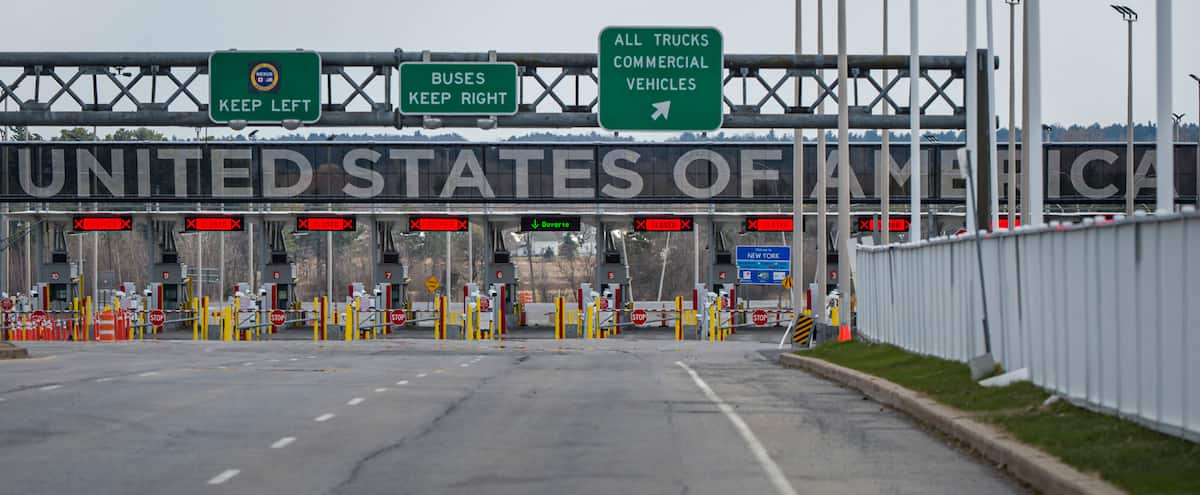The countdown to reopening the US land and air borders began Monday for travelers vaccinated against COVID-19, after 20 months of poorly hit restrictions in Europe or among neighbors Mexico and Canada.
• Read also: Snowbirds camp near the border
Separated families, crippled business relationships, frustrated career ambitions: The “travel ban” imposed by Donald Trump at the beginning of 2020, then confirmed by his successor Joe Biden, has been widely criticized and has become a symbol of the turmoil caused by the pandemic.
To guard against the countries hardest hit by COVID-19, Donald Trump imposed travel restrictions from China in February 2020. Then, on March 13, it was the turn of European countries in the Schengen area. Great Britain and Ireland followed suit a few days later, while the land borders with Mexico and Canada were largely closed.
With all these countries, the intensity of human and economic exchanges is enormous.
“It was so hard, I just want to see my son,” said Alison Henry, a 63-year-old Briton who will fly home to New York on Monday.
Many families on both sides of the Atlantic are anxiously awaiting this reunion. Sure, it has been possible to travel from the US to Europe since last summer, but foreigners living on US soil and holding certain visas had no guarantee of returning home.
To deal with the influx of orders, airlines have increased the number of transatlantic flights. They will use bigger planes, because this deregulation also represents a breath of fresh air for a sector that has plunged into crisis due to the pandemic.
Along the massive Mexican border, many American cities, in Texas or in California, suffered economically from this restriction of trade.
“The pandemic has affected everyone and we are just waiting for our people to come visit us,” Marcos Rivera, owner of a clothing store in El Paso, Texas, told AFP.
Sunny Butler, an accessory store owner in Texas, shows his disbelief. “It’s been almost two years, you see? So when it opens on Monday, I’m going to see it and really believe in it,” she says.
More so, in the north of the continent, wealthy Canadian retirees will be able without fear, at the time of the first frost, to make their annual relocation by car towards Florida and its mouth-watering climate.
Vaccination and testing
More than thirty countries have been affected by the lifting of the “travel ban”. But entry will not be completely free and US authorities intend to monitor the vaccination status of travelers, at the same time they will continue to order negative COVID-19 tests.
For passengers arriving by air, from Monday, the US will require, in addition to proof of vaccination and testing within three days prior to departure, the airlines set up a contact tracing system.
For the land route, the restrictions will be lifted in two phases.
From Monday, people coming for reasons deemed nonessential, for example family or tourism, will be able to cross the Canada or Mexico borders, provided they are vaccinated. People arriving for force majeure reasons – for example truck drivers – will be exempted.
But from January, the vaccination obligation will apply to all visitors crossing the land border, regardless of their reason for entering.
US health officials have indicated that all vaccines approved by the World Health Organization (WHO) will be accepted.
At the moment, according to the emergency procedures of the World Health Organization, these are the vaccines AstraZeneca, Johnson & Johnson, Moderna, Pfizer-BioNTech, India’s Covaxin, Sinopharm and Sinovac. So these two Chinese vaccines will make it possible to cross the US border.
The US authorities have not yet commented on the rise in the number of cases in Europe, where the World Health Organization is once again concerned about the “extremely alarming” transmission rate of COVID-19, which could lead to another half a million deaths. continent by February.
This fourth “massive” wave hits in particular Germany, whose relationship the Biden administration is particularly concerned about.
US chief medical officer Vivek Murthy told him he was “cautiously optimistic” Sunday on ABC about the development of the pandemic in the United States.
One thing is for sure, after months of frustration, nothing will stop Elisabeth Zorse, a 51-year-old managing director who lives in Berlin, from finally going to the US to see her favorite band: the Rolling Stones.
“I have tickets to four concerts, first in Atlanta, then in Detroit, Austin and Hollywood, Florida,” says Ms. Zorse, who took the plane tickets once the borders reopened in the middle of the news. October.
see also

“Extreme twitteraholic. Passionate travel nerd. Hardcore zombie trailblazer. Web fanatic. Evil bacon geek.”

